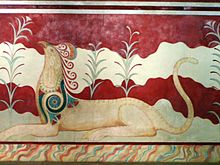
Linear B is a syllabic script that was used for writing in Mycenaean Greek, the earliest attested form of the Greek language. The script predates the Greek alphabet by several centuries, the earliest known examples dating to around 1400 BC. It is adapted from the earlier Linear A, an undeciphered script potentially used for writing the Minoan language, as is the later Cypriot syllabary, which also recorded Greek. Linear B, found mainly in the palace archives at Knossos, Kydonia, Pylos, Thebes and Mycenae, disappeared with the fall of Mycenaean civilization during the Late Bronze Age collapse. The succeeding period, known as the Greek Dark Ages, provides no evidence of the use of writing.

The Minoan civilization was a Bronze Age culture which was centered on the island of Crete. Known for its monumental architecture and its energetic art, it is often regarded as the first civilization in Europe.
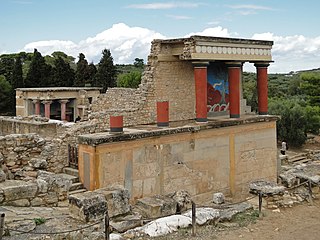
Knossos is a Bronze Age archaeological site in Crete. The site was a major center of the Minoan civilization and is known for its association with the Greek myth of Theseus and the minotaur. It is located on the outskirts of Heraklion, and remains a popular tourist destination.
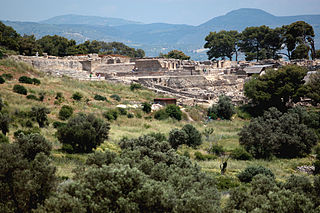
Phaistos ), also transliterated as Phaestos, Festos and Latin Phaestus, is a Bronze Age archaeological site at modern Faistos, a municipality in south central Crete. It is notable for the remains of a Minoan palace and the surrounding town.

Mycenaean Greece was the last phase of the Bronze Age in Ancient Greece, spanning the period from approximately 1750 to 1050 BC. It represents the first advanced and distinctively Greek civilization in mainland Greece with its palatial states, urban organization, works of art, and writing system. The Mycenaeans were mainland Greek peoples who were likely stimulated by their contact with insular Minoan Crete and other Mediterranean cultures to develop a more sophisticated sociopolitical culture of their own. The most prominent site was Mycenae, after which the culture of this era is named. Other centers of power that emerged included Pylos, Tiryns, and Midea in the Peloponnese, Orchomenos, Thebes, and Athens in Central Greece, and Iolcos in Thessaly. Mycenaean settlements also appeared in Epirus, Macedonia, on islands in the Aegean Sea, on the south-west coast of Asia Minor, and on Cyprus, while Mycenaean-influenced settlements appeared in the Levant and Italy.

Spyridon Nikolaou Marinatos was a Greek archaeologist who specialised in the Bronze Age Minoan and Mycenaean civilizations. He is best known for the excavation of the Minoan site of Akrotiri on Santorini, which he conducted between 1967 and 1974. A recipient of several honours in Greece and abroad, he was considered one of the most important Greek archaeologists of his day.

Minoan pottery has been used as a tool for dating the mute Minoan civilization. Its restless sequence of quirky maturing artistic styles reveals something of Minoan patrons' pleasure in novelty while they assist archaeologists in assigning relative dates to the strata of their sites. Pots that contained oils and ointments, exported from 18th century BC Crete, have been found at sites through the Aegean islands and mainland Greece, in Cyprus, along coastal Syria and in Egypt, showing the wide trading contacts of the Minoans.

The Heraklion Archaeological Museum is a museum located in Heraklion on Crete. It is one of the largest museums in Greece and the best in the world for Minoan art, as it contains by far the most important and complete collection of artefacts of the Minoan civilization of Crete. It is normally referred to scholarship in English as "AMH", a form still sometimes used by the museum in itself.

Minoan chronology is a framework of dates used to divide the history of the Minoan civilization. Two systems of relative chronology are used for the Minoans. One is based on sequences of pottery styles, while the other is based on the architectural phases of the Minoan palaces. These systems are often used alongside one another.

Minoan religion was the religion of the Bronze Age Minoan civilization of Crete. In the absence of readable texts from most of the period, modern scholars have reconstructed it almost totally on the basis of archaeological evidence of such as Minoan paintings, statuettes, vessels for rituals and seals and rings. Minoan religion is considered to have been closely related to Near Eastern ancient religions, and its central deity is generally agreed to have been a goddess, although a number of deities are now generally thought to have been worshipped. Prominent Minoan sacred symbols include the bull and the horns of consecration, the labrys double-headed axe, and possibly the serpent.

Mycenaean pottery is the pottery tradition associated with the Mycenaean period in Ancient Greece. It encompassed a variety of styles and forms including the stirrup jar. The term "Mycenaean" comes from the site Mycenae, and was first applied by Heinrich Schliemann.

Minoan art is the art produced by the Bronze Age Aegean Minoan civilization from about 3000 to 1100 BC, though the most extensive and finest survivals come from approximately 2300 to 1400 BC. It forms part of the wider grouping of Aegean art, and in later periods came for a time to have a dominant influence over Cycladic art. Since wood and textiles have decomposed, the best-preserved surviving examples of Minoan art are its pottery, palace architecture, small sculptures in various materials, jewellery, metal vessels, and intricately-carved seals.

Minoan palaces were massive building complexes built on Crete during the Bronze Age. They are often considered emblematic of the Minoan civilization and are modern tourist destinations. Archaeologists generally recognize five structures as palaces, namely those at Knossos, Phaistos, Malia, Galatas, and Zakros.
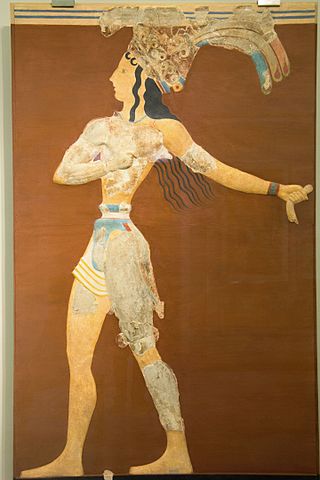
The Prince of the Lilies, or the Lily Prince or Priest-King Fresco, is a celebrated Minoan painting excavated in pieces from the palace of Knossos, capital of the Bronze Age Minoan civilization on the Greek island of Crete. The mostly reconstructed original is now in the Heraklion Archaeological Museum (AMH), with a replica version at the palace which includes flowers in the background.

La Parisienne, also known as the Minoan Lady, is part of the Camp Stool Fresco, which was probably painted on the wall of the Sanctuary Hall on the Piano Nobile at the palace of Knossos. The sacral knot worn at the back of the neck seems to indicate that she is a priestess or even a goddess. The archaeological research in Minoan palaces, cemeteries and settlements has brought to light a multitude of objects related to beautification. Edmond Pottier gave her the name as he felt she resembled a contemporary woman from Paris.

The bull-leaping fresco is the most completely restored of several stucco panels originally sited on the upper-story portion of the east wall of the Minoan palace at Knossos in Crete. It shows a bull-leaping scene. Although they were frescos, they were painted on stucco relief scenes. They were difficult to produce. The artist had to manage not only the altitude of the panel but also the simultaneous molding and painting of fresh stucco. The panels, therefore, do not represent the formative stages of the technique. In Minoan chronology, their polychrome hues – white, pale red, dark red, blue, black – exclude them from the Early Minoan (EM) and early Middle Minoan (MM) Periods. They are, in other words, instances of the "mature art" created no earlier than MM III. The flakes of the destroyed panels fell to the ground from the upper story during the destruction of the palace, probably by earthquake, in Late Minoan (LM) II. By that time the east stairwell, near which they fell, was disused, being partly ruinous.
The Minoan wall paintings at Tell el-Dab'a are of particular interest to Egyptologists and archaeologists. They are of Minoan style, content, and technology, but there is uncertainty over the ethnic identity of the artists. The paintings depict images of bull-leaping, bull-grappling, griffins, and hunts. They were discovered by a team of archaeologists led by Manfred Bietak, in the palace district of the Thutmosid period at Tell el-Dab'a. The frescoes date to the Eighteenth dynasty of Egypt, most likely during the reigns of either the pharaohs Hatshepsut or Thutmose III, after being previously considered to belong to the late Second Intermediate Period. The paintings indicate an involvement of Egypt in international relations and cultural exchanges with the Eastern Mediterranean either through marriage or exchange of gifts.

Knossos, also romanized Cnossus, Gnossus, and Knossus, is the main Bronze Age archaeological site at Heraklion, a modern port city on the north central coast of Crete. The site was excavated and the palace complex found there partially restored under the direction of Arthur Evans in the earliest years of the 20th century. The palace complex is the largest Bronze Age archaeological site on Crete. It was undoubtedly the ceremonial and political centre of the Minoan civilization and culture.

Louis Émile Emmanuel Gilliéron (1850–1924), often known as Émile Gilliéronpère to distinguish him from his son, was a Swiss artist and archaeological draughtsman best known for his reconstructions of Mycenaean and Minoan artefacts from the Bronze Age. From 1877 until his death, he worked with archaeologists such as Heinrich Schliemann, Arthur Evans and Georg Karo, drawing and restoring ancient objects from sites such as the Acropolis of Athens, Mycenae, Tiryns and Knossos. Well-known discoveries reconstructed by Gilliéron include the "Harvester Vase", the "Priest-King Fresco" and the "Bull-Leaping Fresco".
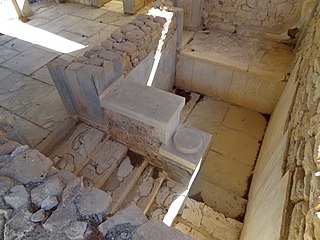
The lustral basin is an architectural form used in Minoan architecture. Consisting of a small sunken room reached by a staircase, they are characteristic of elite architecture of the Neopalatial period.

